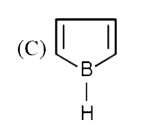Identify the aromatic compound ?




The correct Answer is:B
To identify the aromatic compound among the given options, we can follow these steps:
Step 1: Understand the Criteria for Aromaticity
A compound is considered aromatic if it meets the following criteria:
1. It must be cyclic.
2. It must be planar (or nearly planar).
3. It must have a continuous overlap of p-orbitals (conjugation).
4. It must follow Huckel's rule, which states that the compound must have (4n + 2) π electrons, where n is a non-negative integer (0, 1, 2, ...).
Step 2: Analyze Each Option
- Option A: Check if it is cyclic, planar, and has conjugation. If there is a break in conjugation, it cannot be aromatic.
- Option B: Check for cyclic structure, planarity, and the number of π electrons. If it follows Huckel's rule, it is aromatic.
- Option C: Count the π electrons. If it has 4 π electrons, it is anti-aromatic, which means it cannot be aromatic.
- Option D: Determine if there is any conjugation. If there is none, it cannot be aromatic.
Step 3: Identify the Correct Option
After analyzing the options:
- Option A is not aromatic due to broken conjugation.
- Option C is anti-aromatic due to having 4 π electrons.
- Option D lacks conjugation, making it non-aromatic.
- Option B has conjugation and follows Huckel's rule, making it the aromatic compound.
Conclusion
The aromatic compound among the options is Option B.
---
A compound is considered aromatic if it meets the following criteria:
1. It must be cyclic.
2. It must be planar (or nearly planar).
3. It must have a continuous overlap of p-orbitals (conjugation).
4. It must follow Huckel's rule, which states that the compound must have (4n + 2) π electrons, where n is a non-negative integer (0, 1, 2, ...).
- Option A: Check if it is cyclic, planar, and has conjugation. If there is a break in conjugation, it cannot be aromatic.
- Option B: Check for cyclic structure, planarity, and the number of π electrons. If it follows Huckel's rule, it is aromatic.
- Option C: Count the π electrons. If it has 4 π electrons, it is anti-aromatic, which means it cannot be aromatic.
- Option D: Determine if there is any conjugation. If there is none, it cannot be aromatic.
After analyzing the options:
- Option A is not aromatic due to broken conjugation.
- Option C is anti-aromatic due to having 4 π electrons.
- Option D lacks conjugation, making it non-aromatic.
- Option B has conjugation and follows Huckel's rule, making it the aromatic compound.
The aromatic compound among the options is Option B.
Topper's Solved these Questions
- GENERAL ORGANIC CHEMISTRY-IBOOK - RESONANCECHAPTER - GENERAL ORGANIC CHEMISTRY-IEXERCISE - EXERCISE-1 PART-III (MATCH THE COLUMN)
1 Videos
- GENERAL ORGANIC CHEMISTRY-IBOOK - RESONANCECHAPTER - GENERAL ORGANIC CHEMISTRY-IEXERCISE - EXERCISE-2 PART-I
20 Videos
- GENERAL ORGANIC CHEMISTRY-IBOOK - RESONANCECHAPTER - GENERAL ORGANIC CHEMISTRY-IEXERCISE - EXERCISE-1
16 Videos
- GENERAL ORGANIC CHEMISTRY IIBOOK - RESONANCECHAPTER - GENERAL ORGANIC CHEMISTRY IIEXERCISE - Part-III: Section-5: Matching List Type
1 Videos
- HYDROGEN AND ITS COMPOUNDSBOOK - RESONANCECHAPTER - HYDROGEN AND ITS COMPOUNDSEXERCISE - INORGANIC CHEMISTRY(Hydrogen & its compunds Y environment chemistry)
33 Videos
Similar Questions
Knowledge Check
Aromatic compounds are
Acyclic compoundsBaliphatic compoundsCsaturated compoundsDAll of the aboveAromatic compounds are:
A B
B C
C D
D
Aromatic compounds are :
AOpen-chain compoundsBclosed-chain compoundsCboth open and closed-chain compundsDClosed-chain compounds which are structurally similar to benzene
